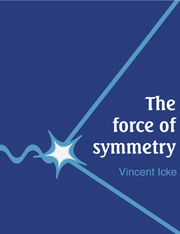Book contents
- Frontmatter
- Contents
- Preface
- Introduction
- 1 A matter of force
- 2 Stalking the wild rainbow
- 3 Light
- 4 Maybe I'm Heisenberg
- 5 Catch a falling quantum
- 6 Quantum beanbags
- 7 Symmetries
- 8 Quantum relativity: nothing is relative
- 9 Life, the Universe and everything
- 10 The physics of a tablecloth
- 11 Colour me red, green and blue
- 12 Smashing symmetry
- 13 How much is infinity minus infinity?
- 14 Excelsior! The ascent to SU(∞)
- A modest reading proposal
- References
- Glossary
- Index
6 - Quantum beanbags
Published online by Cambridge University Press: 05 August 2012
- Frontmatter
- Contents
- Preface
- Introduction
- 1 A matter of force
- 2 Stalking the wild rainbow
- 3 Light
- 4 Maybe I'm Heisenberg
- 5 Catch a falling quantum
- 6 Quantum beanbags
- 7 Symmetries
- 8 Quantum relativity: nothing is relative
- 9 Life, the Universe and everything
- 10 The physics of a tablecloth
- 11 Colour me red, green and blue
- 12 Smashing symmetry
- 13 How much is infinity minus infinity?
- 14 Excelsior! The ascent to SU(∞)
- A modest reading proposal
- References
- Glossary
- Index
Summary
A muddy wheel
After this excursion into the laboratory, let us return to the discussion of the equation of quantum motion. As in the case of classical mechanics, we start with the Descartes approach: what does a quantum do in the absence of forces? A classical particle moves with constant velocity when there are no forces; what does a quantum do? Picking out just one path for the quantum to follow would offend against the uncertainty relations. In fact, we must do exactly the opposite: each path that is not explicitly forbidden, and that is not distinguished from other paths in any way, must be allowed as a possible alternative.
The mere fact that a path traces a given curve through space and time is not enough to distinguish it from a differently traced alternative. After all, as long as the quantum does not interact with others along the road, there is no way to determine where it has been (this is the essence of the whole preceding chapter). Interactions along the path correspond to the appearance of forces, and these we had pointedly excluded; the action of a force is a way to distinguish among paths. All force-free paths are to be considered collectively as equal-rights alternatives.
- Type
- Chapter
- Information
- The Force of Symmetry , pp. 80 - 99Publisher: Cambridge University PressPrint publication year: 1995

